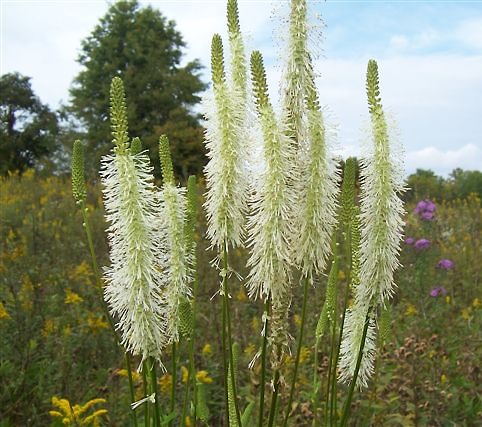Description: This perennial wildflower is about 2-5' tall. The stems are light green and glabrous (or nearly so). Alternate compound leaves up to 1½' long are located mostly along the lower half of each plant; they are widely spreading. Each compound leaf is odd-pinnate with 7-15 leaflets. The leaflets are about 1-2½" long and a little less than one-half as much across; they are oblong in shape and coarsely serrated along their margins. Some leaflets are a little wider toward their bases than their tips. Upper leaflet surfaces are medium green and glabrous, while their lower surfaces are a slightly lighter shade of green. The leaflets have short petiolules (short slender stalklets) at their bases that connect them to the rachis (central stalk) of the compound leaf. The compound leaves have petioles up to 6" long. Coarsely toothed stipules are located at the bases of the petioles.

Upper stems
terminate in cylindrical spikes of whitish flowers about 2-8" long and
1" across. The long naked peduncles of the floral spikes are light to
medium green and glabrous; they are either unbranched or divide into
2-3 erect stalks, with each stalk bearing a floral spike at its apex.
There is a small toothed bract at the base of each division. The
flowers are densely packed together all around the central axis of the
spike. Each flower consists of a calyx with 4 spreading lobes, 4 long
exerted stamens, and a pistil; there are no true petals. The petaloid
calyx is greenish white to white and about ¼" across. The stamens
(about ½" long) have long white filaments that are very conspicuous.
Because of these abundant filaments, the floral spike resembles a white
bottlebrush. The blooming period occurs from mid-summer to early fall
and lasts about 1-2 months. During the fall, the flowers are replaced
by 4-winged capsules that each contain a single seed. These small
capsules (about ¼" long) can probably float on water. The root system
at the base of the plant is stout and rather woody from its abundant
tannins; it usually develops underground
runners that form vegetative
offsets.
Cultivation:
The preference is full sun, wet to moist conditions, and soil
containing some organic matter.
Range & Habitat:
The native American Burnet has been found in only a few counties of
Illinois. It
is quite rare and state-listed as 'endangered.' Illinois lies at the
western range limit for this species. This wildflower is more abundant
in some areas of New England and the Mid-Atlantic states. In Illinois,
American Burnet has been found in wet to moist prairies (primarily
along railroads) and fens. In other states, it has been found in low
areas along rivers, peaty bogs, and swamps.
Faunal Associations:
Remarkably little appears to be known about floral-faunal relationships
for this plant. The odd-looking flowers produce abundant pollen and
possibly some nectar; they attract various bees (including honeybees)
and probably other insects. The leaves are somewhat bitter from the
presence of tannins and saponins, but it is unclear to what extent this
deters mammalian herbivores from consuming them.
Photographic Location:
A prairie in Fayette County, Illinois. The flowering plant was
photographed by Keith & Patty Horn (Copyright © 2009).
Comments:
American Burnet is an attractive wildflower that should be cultivated
in gardens more often. This is the only native Sanguisorba sp.
(Burnet) in Illinois and the surrounding area. Two European species
that are occasionally cultivated, Sanguisorba officinalis
(European Great Burnet) and Sanguisorba minor
(Garden Burnet), are smaller in size and they have less attractive
purple or brown flowers on shorter spikes. While these latter two
species occasionally escape into the wild, they do not appear to be
aggressive in our area. Another common name of Sanguisorba
canadensis is Canadian Burnet.